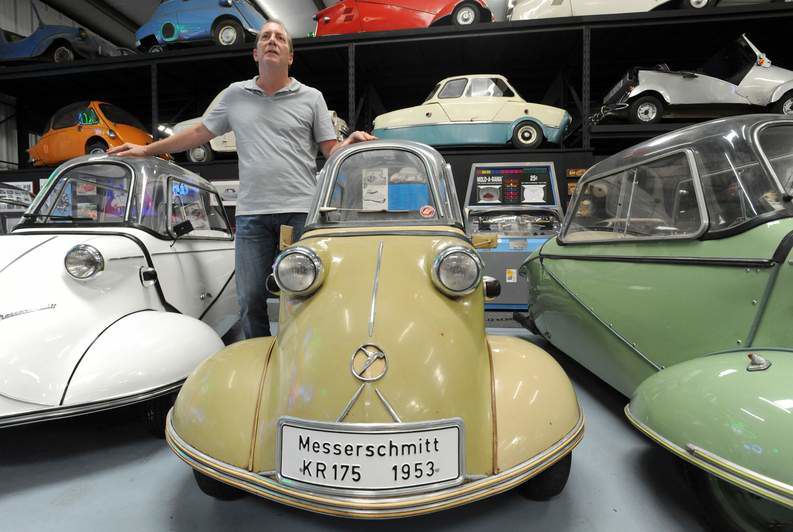The tiny cars that moved Europe
Published 5:00 am Friday, October 22, 2010

- Bruce Weiner, founder of the Microcar Museum, with some of his Messerschmitts displayed at the museum in Madison, Ga. Weiner's museum celebrates a little-known but intriguing chapter in automotive history that took place in postwar Europe.
This little car has come a long way.
Restored and repainted, it sits in a climate-controlled, 25,000-square-foot museum, 50 miles outside of Atlanta, far from its origins on the ruined, rubble-strewn roads of postwar Germany.
The Messerschmitt KR 175 was originally built for a far-away era, when a population in dire need of transportation turned to engineering solutions to solve their problems — whether it was transporting amputees who had been wounded in the war, getting to market or taking the family on a picnic.
The KR 175 was one of the first of a class of vehicles that would become known as microcars, defined as cars with engines smaller than 750 cubic centimeters. The KR 175 was less than 10 feet long and weighed 396 pounds. Befitting a vehicle bearing the nameplate of a company known for its fighter planes for the Luftwaffe, the 1-cylinder, 9-horsepower Messerschmitt also featured a plexiglass passenger compartment dome that resembled an airplane cockpit.
It’s tiny, it’s fascinating, it’s still futuristic looking — and it’s here with about 300 of its fellow minivehicles at the Bruce Weiner Microcar Museum in Madison, Ga. The museum celebrates a little-known but intriguing chapter in automotive history that did not originate in the United States. Because while Americans were buying bigger and bigger cars in the late 1940s and 1950s, Europeans were thinking small.
They had little choice.
“These cars were a response to desperate conditions,” said Peter Svilans, a microcar restorer and historian in Toronto. “But today they should be appreciated as a wonderful merging of technology and art.”
Indeed, the flair of their designers is evident in startling features like the three wheels of the KR 175 (Messerschmitt later added a fourth), or the Italian-designed Isetta, in which the door is the entire front of the car (it opens out, steering wheel and all, and the driver climbs in).
It was also the Isetta’s egglike shape that inspired the phrase by which the micros are known in some circles: bubble cars.
The flair of these vehicles is matched by Bruce Weiner, who found and brought them to the United States. Weiner, 51, a wealthy entrepreneur with a passion for collecting little cars and other unusual things, says he has been interested in cars since he was a teenager in Florida. He said he saw a picture of a Messerschmitt in an automotive trade magazine about 20 years ago and, “was fascinated. It was just so cool, so different than any other car I’d ever seen.”
Weiner had parlayed an interest in, of all things, bubblegum, which he collected, into ownership of Dubble Bubble, the bubblegum company (he sold it in 2004).
With a similar zeal, he started collecting microcars in 1991 and has found them in barns, garages or even in pieces and stored in boxes all over Europe. “With microcars, you don’t just show up with a wad of cash and say sell it to me,” he said. “At least not in Europe, which is where 90 percent of these cars were. There, they mean something more. It’s like you showing up and asking me to sell my dad’s watch.”
Weiner, a divorced father of two, opened the museum on 72 acres he owned in Madison in 1997. Many American visitors who follow the signs off of Highway 441 aren’t quite sure what a microcar is.
“I think a lot of people come in here expecting to see Hot Wheels, the little toys,” said Mark Hagler, laughing, who’s general manager of the museum and the adjacent restoration shop in which the cars are maintained.
Indeed, climbing into a French-made 1957 Rovin Z-4 for a test ride with Hagler, one has the feel of stepping down into a kiddie ride. But as he brings the car up to 40 miles per hour, it’s evident that these are not toys.
What doomed them, however, was economic prosperity. By the early 1960s, larger (at least by European standards) automobiles, mass produced by today’s familiar names like Volkswagen, Renault and Fiat, began to dominate the roads. “The mini completely demolished the micro,” said Svilans.
This consigned the bubble cars to museums, and in the case of the Messerschmitt KR 175, rare ones at that. There were 15,000 of them manufactured from 1953 to 1955. Only 50 are known to still exist. It’s likely few have traveled farther from the factory in Regensburg, where they were built, than the one that sits in the Microcar Museum, a prime example of what the museum’s brochure hails as the “small wonders” of automotive history.






